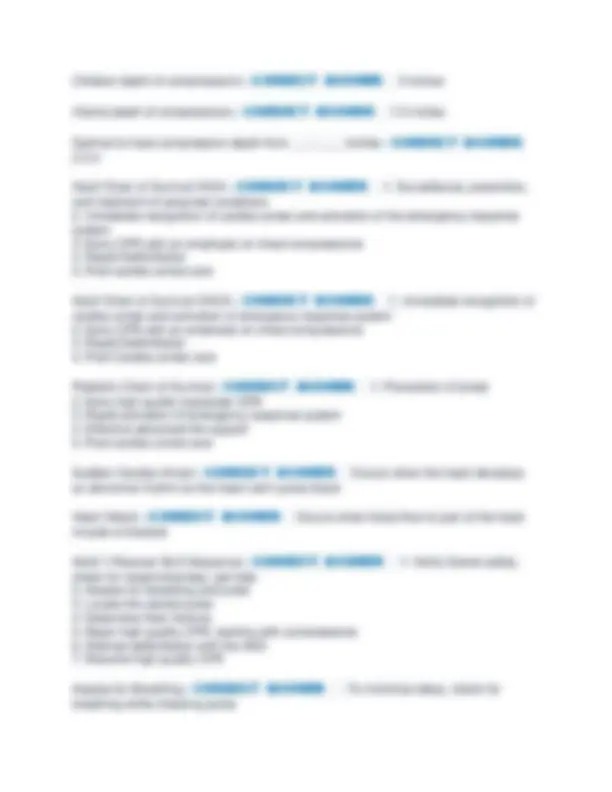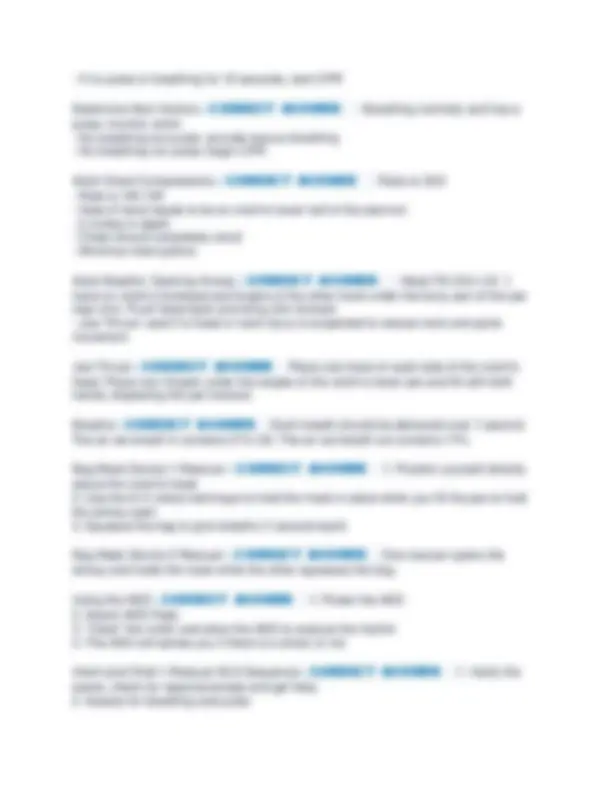





Study with the several resources on Docsity

Earn points by helping other students or get them with a premium plan


Prepare for your exams
Study with the several resources on Docsity

Earn points to download
Earn points by helping other students or get them with a premium plan
Community
Ask the community for help and clear up your study doubts
Discover the best universities in your country according to Docsity users
Free resources
Download our free guides on studying techniques, anxiety management strategies, and thesis advice from Docsity tutors
AHA BLS Practice Test Questions ACTUAL EXAM] LATEST VERSION [78 QUESTIONS AND ANSWERS] WITH STUDY GUIDE DETAILED AND VERIFIED FOR GUARANTEED PASS- LATEST UPDATE 2025 GRADED A
Typology: Exams
1 / 6

This page cannot be seen from the preview
Don't miss anything!




When is it acceptable to move an adult victim who needs CPR? - CORRECT ANSWER when an adult/ victim is in a dangerous environment High quality CPR includes starting chest compressions within how many seconds after recognition of cardiac arrest in victims of all ages? - CORRECT ANSWER 10 seconds Interruptions of chest compressions should be limited to how many seconds? - CORRECT ANSWER 10 seconds How can you tell when a rescue breath for an infant victim is effective? - CORRECT ANSWER there is visible rise of the chest What is the best method of opening the airway of an unresponsive victim when you do not suspect cervical spine injury? - CORRECT ANSWER use the head tilt chin lift What is likely to cause air to enter the victims stomach (gastric inflation) during bag mask ventilation? - CORRECT ANSWER breaths are given to quickly or with to much force How does complete chest recoil contribute to effective CPR? - CORRECT ANSWER allows the heart to refill with blood between compressions What is the recommended compression- ventilation ratio for 2 rescuer adult CPR? - CORRECT ANSWER 30:2 for 2 rescuer To reduce fatigue during CPR, how often should those performing compressions switch roles? - CORRECT ANSWER after every 5 cycles of compressions and breaths What is the recommended compression rate for performing CPR on a victim of any age? - CORRECT ANSWER 100 - 120 per min Why are chest compressions important? - CORRECT ANSWER they pump blood to the rest of the body What is the first step to perform once the AED arrives on the scene? - CORRECT ANSWER turn on the AED
When should you deliver a shock from the AED? - CORRECT ANSWER once charged and after an audible and visual "clear the victim" What is the best way to relieve severe chocking in a responsive adult? - CORRECT ANSWER perform abdominal thrusts until the object is removed What is the correct depth of chest compression for a child victim? - CORRECT ANSWER at least one third the depth of the chest, approx 2 inches What is the recommended compression ventilation ration for 2 rescuer child CPR? - CORRECT ANSWER 15: What size AED pads should be used for child less than 8 years of age? - CORRECT ANSWER pediatric pads (adult pads may be used if pedi pads are not available) A choking adult becomes unresponsive while you are doing abdominal thrusts. What should you do next? - CORRECT ANSWER begin CPR What is the recommended compression ventilation ratio for 1 rescuer infant CPR - CORRECT ANSWER 30: What is the preferred technique for providing chest compressions during 2 rescuer CPR for an infant? - CORRECT ANSWER the 2 thumb - encircling hands technique Where is the brachial pulse located on an infant? - CORRECT ANSWER on the inside of the upper arm between the elbow and the shoulder. Adult - CORRECT ANSWER After the onset of puberty and older Children - CORRECT ANSWER 1 year of age to puberty Infants - CORRECT ANSWER Less than 1 year of age Start compressions within _______seconds of recognition of cardiac arrest? - CORRECT ANSWER 10 Compress at a rate of _________/min - CORRECT ANSWER 100 - 120 Adult depth of compressions - CORRECT ANSWER 2 inches